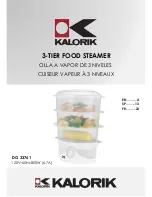
24
NOTE:
Never use force to open your pot. It should open with minimal effort. When it
does not, this indicates that there may still be internal pressure.
6. HOW TO SAFELY USE YOUR PRESSURE COOKER
SEALING RING (SILICONE):
• Remove the sealing ring (silicone).
• Wash with warm water and mild soap.
• Place ring in the lid.
• Check the condition of the silicone sealing ring
regularly for wear and tear and replace when necessary.
• For the Sealing Ring to last longer, we recommend
10
• Before closing the cooker, be sure there is
enough liquid to produce steam when heated
(see the table for food and liquid quantities).
However, never exceed the maximum limit
indicated on the cooker, considering food and
water (fig. 10).
• When making soup or broth, do not fill the
pot more than halfway with food and water.
Overfilling the pressure cooker with food can lead to the obstruction of valves due
to broth leaking through the working valve, which can compromise the performance
of the cooker.
WORKING VALVE (PRESSURE RELEASE):
• After each use, make sure the pressure regulator and steam outlet pin are unclogged.
If they are not, clean as described in the section below:
• Take the lid off your pressure cooker, remove the Pressure Regulator and the
metallic filter and place the lid against the light to check whether the Steam Outlet Pin is
unclogged. If it is not, clean it with a wire, as well as the three holes of the Steam Outlet
Pin on the inside of the lid; look at it again against the light to make sure. When they are
all clean, assemble the Pressure Regulator and the metal filter.
storing your pressure cooker with the lid inverted on top of the cooker body.
• Special attention should be paid to the cooker’s sealing ring and safety systems. The
sealing ring should fit snugly inside the lid and the lid should fit properly on the cooker.


































